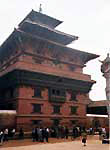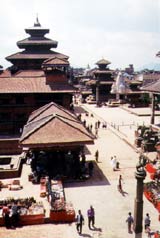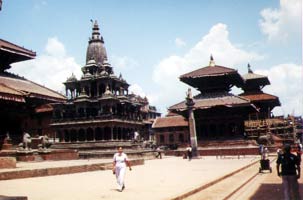|
Patan
Museum and its sustainability
|
 |
 |
| Patan
is honoured as one of the three old cities of Nepal. There is little historical
evidence, which sheds light on its antiquity. Some chronicles mention Emperor
Ashoka's visit to the Valley in 250 BC and the erection of the five Ashoka
Stupas, four of them in the four cardinal directions and one in the middle
of Patan city. Patan developed into a melting pot of art, architecture
and culture and is thus called "City of Fine Arts". Patan Durbar Square
situated in the heart of the city, attracts visitors to this city. |
|
The
square is adorned with a magnificent ancient palace, various temples and
shrines in different styles, art work and architectural monuments, illustrating
the skill of ancient hands on stone, metal and wood.
Patan
Durbar square consists of three main Chowks or Courtyards, the central
Mulchowk, Sundari Chowk, and Keshav Narayan Chowk. Keshav Narayan Chowk
was famous under the name of Chaukawath Durbar.
The
ultimate result is a self sustaining, world-class museum that attracts
40,000 visitors a year or 5 percent of the total number of tourists visiting
Nepal. It has been acclaimed around the world and its growing popularity
guarantees its sustainability in future. A decaying old building has gained
a new life with the preservation of ancient arts and cultural. It will
certainly be Nepal's pride for the coming generations.
 |
| Almost
all the historical documents mention Chaukawath Durbar. The local
people are of the opinion that before the construction of Chaukwath Durbar
a monastery called Ratnakara Mahavihar occupied the site. Once a year,
a square copper vessel is placed in front of the gate. It contains an image
of the Akshoby Buddha emerged in water. For a whole month, this image is
worshipped in a public ritual recalling the ancient sanctity of the spot
at the edge of a stream. However, its normal home is an old residential
court of Patan Durbar, one of the royal palaces of the former Malla kings
who ruled over the Valley. |
|
The
massive earthquake in 1934 caused terrible damage to the palace. It was
restored with the joint efforts of His Majesty's Government and the Austrian
Government. Some modern elements were added to the building, as part of
the renovation and the result is a beautiful blend of old and new architecture.
Only
new feature added is a pair of bronze plaques flanking the gate. They were
made through the traditional 'lost wax' casting process. The interior of
the museum has been beautifully restored with dramatic lighting and spotlights.
Restoration of Patan's former royal palace and it's adaptation to a museum
occurred in the period 1983-1997. The project began with the restoration
of the most endangered wing of Keshav Narayan Chowk. Over the years,
all parts of the palace premises were included in the conservation and
reconstruction programme with an additional wing converting the whole into
a museum of international standard for the permanent exhibition of the
ancient art of Nepal. Completed at a total cost of 2.7 million US$ and
established as a semi -autonomous and self -sustaining cultural institution,
the museum was inaugurated by His Majesty King Birendra Bir Bikram Shah
Dev on October 28, 1997.
|
Main
feature of the museum
|
The
main feature of the museum is an outstanding collection of cast bronze
and gilt copper Hindu and Buddhist deities, mostly created in the valley,
many in nearby workshops Patan itself. Others originated in India, Tibet
and the western Himalayas. Mary Slusser, one of the leading experts on
the cultural history of Nepal, was involved in the museum project for several
years. She studies the existing collection of more than 1,500 objects,
selected fewer than 200 of them to be put on permanent display and advised
on the acquisition of additional exhibits.
|
The
9 galleries of the Museum
|
This
museum contains 9 galleries. The ground floor arcade and the main staircase
play a vital role in attracting visitors.
Gallery
'A'
The
small gallery 'A' illustrates how to recognize Hindu and Buddhist deities
by a combination of symbolic features such as how they sit or stand, how
they hold their hands and what they hold in them, what ornaments and dresses
they wear, who and what accompanies them, and various associated animals,
birds and other beings known as mounts or vehicles such as the humanized
bird Garuda which accompanies Vishnu and the bull Nandi, Shiva's mount.
Gallery
'B'
Similarly,
Gallery 'B' is devoted to Hinduism. The Gallery introduces and presents,
various manifestations of the great god Shiva, his consort Parvati, and
the familiar Ganesh. In addition, the stolen 12th century stone, Uma Maheshor,
returned from the Berlin Museum is a big draw.
Gallery
'C'
There
are also various images and artifacts of Vishnu. Some show him with his
consort Laxmi and some with Garuda in gallery 'C'. The image of a fluting
Vishnu on Garuda is very nice to see in this gallery. A rare, ivory-handled
bronze mirror and other ivory objects are magnificent examples of ivory
carving. A gilded throne with inscriptions of the former Malla Kings of
Patan is also a most important object. Similarly, a painting of Krishna
Lila from the 17th century is notable.
Gallery
'E'
Gallery
'E' devoted to Buddhism is the other gallery that has been drawing in most
of the Buddhist visitors. This gallery introduces the genesis and evolution
of the various schools of Buddhism. There are various Buddhist images on
display, including a group of rare 11th & 12th century bronzes originated
in India. The major attractions are the images of Sakyamuni Buddha, 12th
century, Dipankar Buddha 17-18th, and a large-scale model of Bodnath.
Gallery
'F'
The
emphasis in gallery 'F' is on the Buddha and Chaityas. This gallery concentrates
on the spiritual guides who in many forms, peaceful, fierce and ostensibly
erotic, lead humans to salvation and Buddhahood.
Gallery
'G'
Gallery
'G' depicts the metallurgical arts. Illustrations of the hammer bitten
and lost wax processes can be observed here. Similarly, the silver seathing
of the original Bagalamukhi shrine is also on exhibit. Furthermore, fascinating
photographs of different world heritage sites and others taken at the turn
of the century are on view.
The
illustrated manuscripts in Gallery D, E and M are also considered
exquisite exhibits.
| During
the peak season, the museum has logged up to one hundred visitors per day.
Otherwise, a minimum of 50 tourists visit the museum daily. But the number
of tourists visitors has nose-dived, following the levying of an entrance
fee of Rs 200 on foreign tourists since January 1st 2000 by Lalitpur
sub-metropolis. After paying that much just to enter the palace complex,
only a few tourists would be ready to pay an additional entrance charge
of Rs 120 for the museum. The entrance fee levied by sub-metropolis has
not only discouraged tourists, but affected the business stalls and Patan
Museum Cafe which is in operation inside Keshav Narayan Chowk.
In
order to generate revenue, the museum has now raised its ticket price
to Rs 250 effective from the 1st of Baisakha 2058 BS. The museum has
also upgraded its services to the International standard with a number
of facilities including a guest studio for foreign scholars and artists.
The main and back courtyards remain open for cultural events in the afternoon
and evening. A gift shop focusing on Nepal's art and culture is also open
here. |
 |

|
 |
 |
 |
 |
|








